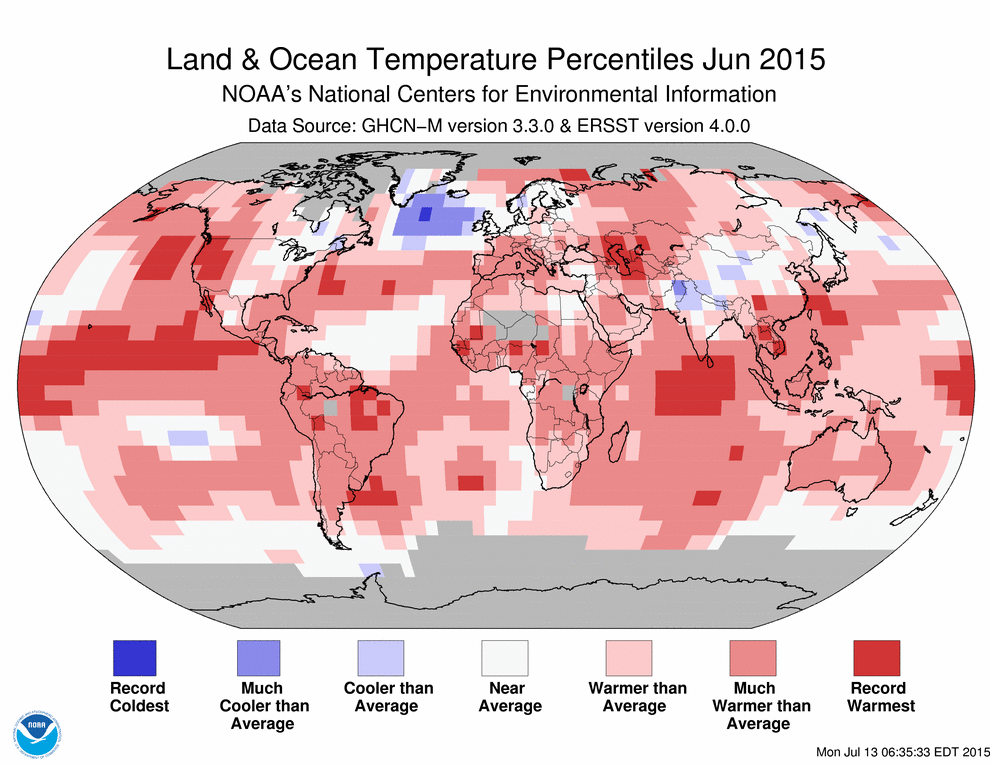Record-breaking temps. over global land & oceans in June, 1st half of 2015, past 12 months
First half of 2015 was record warm for the globe, while June 2015 was warmest June on record, with global land areas and oceans each breaking previous records, according to The State of the Climate Report issued by NCDC/NOAA.
The following are some of the key highlights from the report:
Global highlights: Year-to-date (January–June 2015)
The globally averaged temperature across land and ocean surfaces (SST) was 0.85°C (1.53°F) above the 20th century average, which was the highest for the 6-month period in the 1880–2015 record, surpassing the 2010 record by 0.09°C (0.16°F).
NOTES:
The globally-averaged land and SST temperature for January to June 2010 was 14.2°C (57.5°F), or 0.68°C (1.22°F) above the 20th century average.
The 20th century average land surface and SST temperature for January to June period, as quoted in 2014, was of 13.5°C (56.3°F)
The globally-averaged land surface temperature was 1.40°C (2.52°F) above the 20th century average, which was the highest for January–June in 136-year record, surpassing the 2007 record by 0.13°C (0.23°F).
The globally-averaged SST was 0.65°C (1.17°F) above the 20th century average, which was the highest for the 6-month period in the 1880–2015 record, surpassing the 2010 record by 0.07°F (0.04°C).
Global highlights: June 2015
The combined average temperature over global land and ocean surfaces for June 2015 was the highest for June in the 136-year period of record, at 0.88°C (1.58°F) above the 20th century average of 15.5°C (59.9°F), surpassing the previous record set just one year ago by 0.12°C (0.22°F). This was also the fourth highest monthly departure from average for any month on record. The two highest monthly departures from average occurred earlier this year in February and March, both at 0.90°C (1.62°F) above the 20th century average for their respective months, while January 2007 had the third highest, at 0.89°C (1.60°F) above its monthly average.
The average global temperature across land surfaces was 1.26°C (2.27°F) above the 20th century average of 13.3°C (55.9°F), the highest June temperature on record, surpassing the 2012 record by 0.06°C (0.11°F).
The global sea surface temperature for June was 0.74°C (1.33°F) above the 20th century average of 16.4°C (61.5°F), the highest for June on record, surpassing the 2014 record by 0.06°C (0.11°F). [This also tied with September 2014 as the highest monthly departure from average for any month for the globally-averaged sea surface temperature. Nine of the ten highest monthly departures from average have occurred since May 2014.]
June 2015 also marks the fourth month this year that has broken its monthly temperature record, along with February, March, and May. The other months of 2015 were not far behind: January was second warmest for its respective month and April was third warmest. These six warm months combined with the previous six months (four of which were also record warm) to make the period July 2014–June 2015 the warmest 12-month period in the 136-year period of record, surpassing the previous record set just last month (June 2014–May 2015).
| Rank 1 = Warmest Period of Record: 1880–2015 |
12-month Period | Anomaly °C | Anomaly °F |
|---|---|---|---|
| 1 | July 2014–June 2015 | 0.83 | 1.49 |
| 2 | June 2014–May 2015 | 0.82 | 1.48 |
| 3 | May 2014–April 2015 | 0.81 | 1.46 |
| 4 | April 2014–March 2015 | 0.80 | 1.44 |
| 5 | March 2014–February 2015 | 0.79 | 1.42 |
| 6 (tie) | January–December 2014 | 0.78 | 1.40 |
| 6 (tie) | February 2014–January 2015 | 0.78 | 1.40 |
| 8 | December 2013–November 2014 | 0.77 | 1.39 |
| 9 | November 2013–October 2014 | 0.74 | 1.33 |
| 10 (tie*) | October 2013–September 2014 | 0.73 | 1.31 |
*ties with four other 12-month periods. NOAA National Centers for Environmental Information, State of the Climate: Global Analysis for June 2015, published online July 2015, retrieved on July 22, 2015 from http://www.ncdc.noaa.gov/sotc/global/201506.
Related Links
- 2014 Was Warmest Year on Record July 20, 2015
- Billion-Dollar Weather and Climate Disasters – 2014 Update June 19, 2015
- Earth’s Fever Continues: Warmest May on Record June 19, 2015
- January–April Global Temperature Highest Ever Recorded May 20, 2015
- Warmest Ever: March and Q1, 2015 April 18, 2015
- December–February Warmest on Record March 21, 2015


